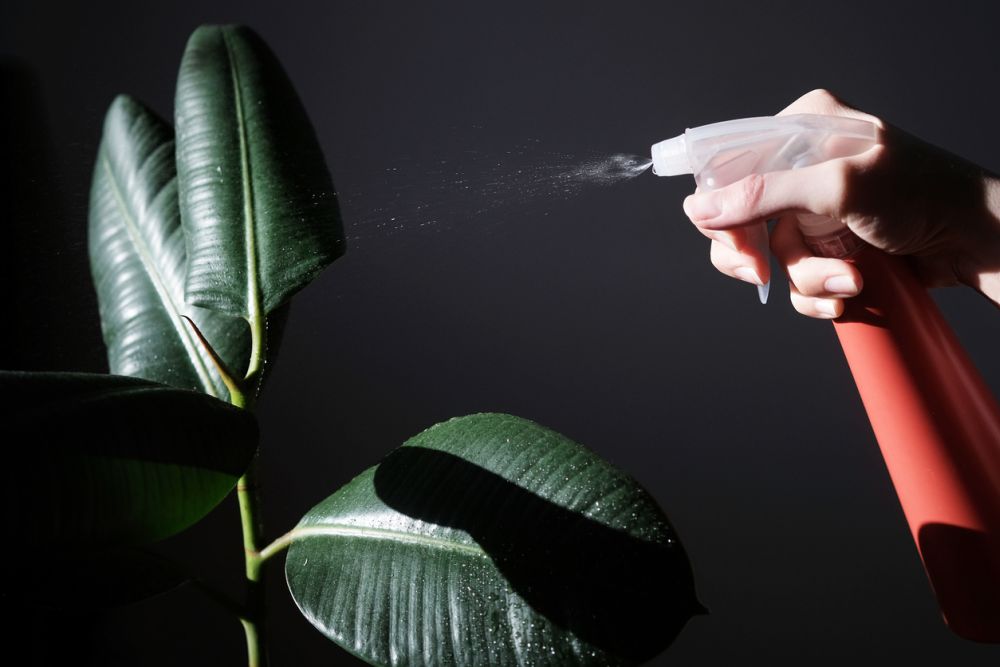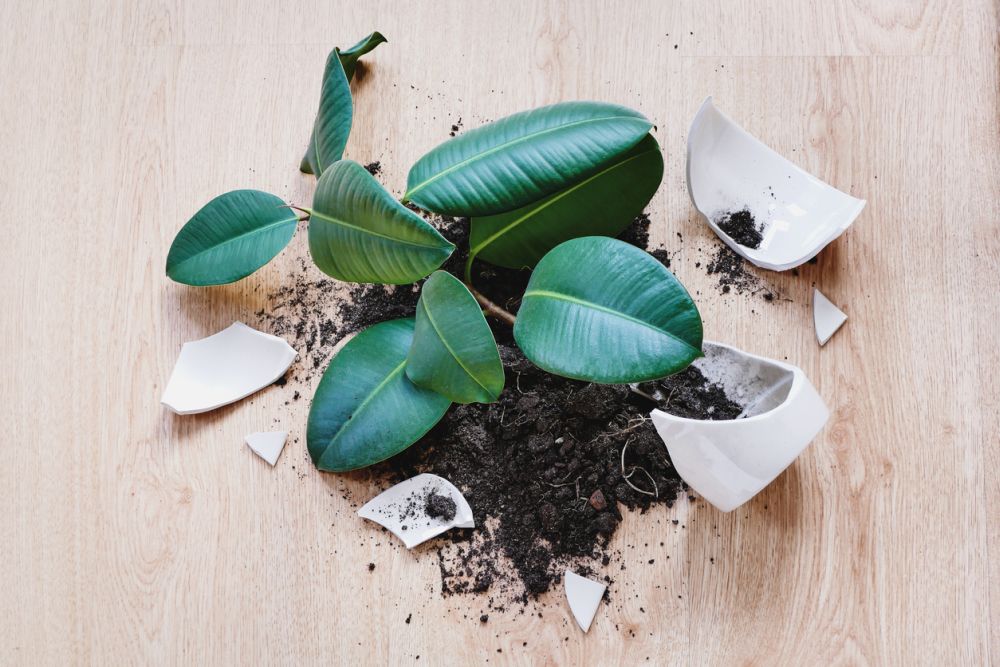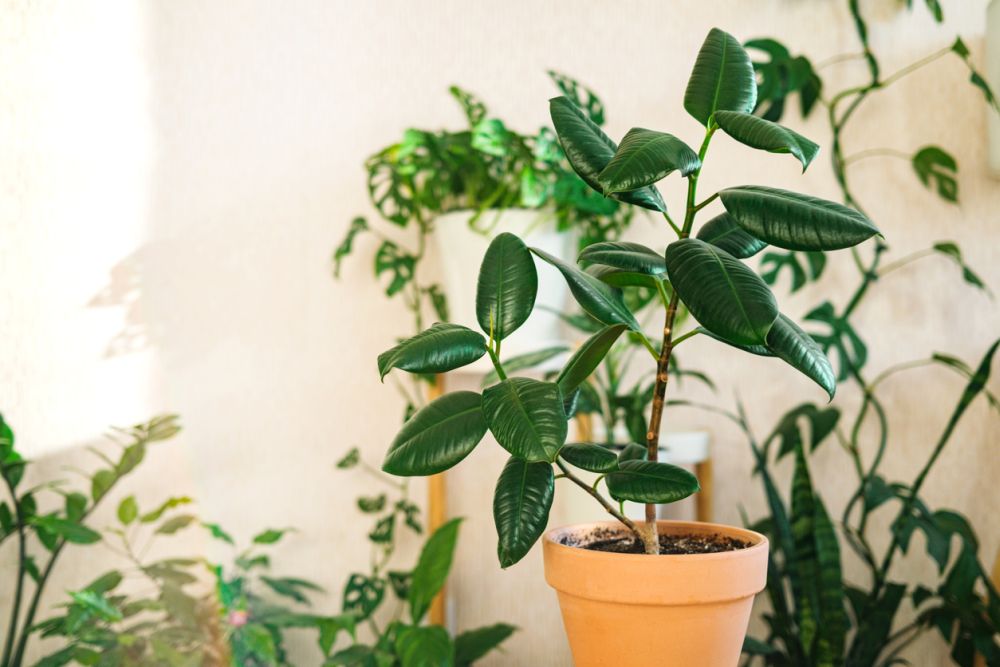How to Repot a Rubber Plant to Keep Your Ficus Elastica Healthy and Vibrant
Repotting a rubber plant may seem like an ordeal, but it’s actually a pretty simple job. Read on to discover the correct steps for transferring a ficus elastica to a new pot.
This article teaches you how to repot a rubber plant in just a few steps. You will also learn the necessary supplies, reasons for repotting a rubber plant, tips for caring for your ficus elastica during the transplant shock period, and additional information.
Why should I repot a rubber plant?
There are many reasons to repot a rubber tree plant:
- Overgrown plant: Rubber tree plants are naturally fast growers – more than 20 inches (51 centimeters) per season), and their root systems grow accordingly. Repot your rubber plant when it becomes top-heavy and tips over easily.
- Slow growth: If your ficus elastica takes too long to grow, it’s likely because the root system is constricted, so you must transfer the plant to a bigger pot.
- Overgrown roots: Also known as root-binding, overgrown roots are a common reason for moving a rubber plant to a bigger pot. The roots grow to the point when they start protruding through the drainage hole. In more severe cases, the roots push the whole plant out of its pot.
- Sickly-looking plant: Overgrown roots don’t have enough space to thrive by absorbing water and nutrients efficiently, making the rubber plant look sickly. So if the plant looks underfed despite regular watering and feeding, repotting is overdue.
- The soil doesn’t retain moisture: As the roots grow and take up the pot, no more soil will be left to retain moisture. Water your plant to see if the water quickly seeps through the drainage holes, which indicates that your rubber plant needs a bigger pot.
- Root rot: A root-bound rubber plant asks for more water, which promotes mold and fungus growth, leading to root rot. If your rubber plant shows signs of root rot, you must repot it.
- Depleted soil: No amount of fertilization and care will prevent soil from getting stale and depleted over time. So it’s best to replace the soil with a fresh batch regularly.
- Deformed or cracked pot: A clear sign that your rubber plant needs a new home is due to an overgrown root system that has deformed or even cracked the pot.
Supplies for repotting a rubber plant
- Gardening gloves to protect your skin from the rubber tree’s sap.
- Plastic foil to wrap the plant’s stem before repotting.
- A new pot about 2-3 inches (5-8 centimeters) wider than the rubber plant’s root ball. It should have at least one drainage hole.
- Porous material to line the bottom part of the new pot and improve drainage.
- Gardening shears to cut any roots that are dead, damaged, or affected by fungi, mold, or pests.
- A trowel or a butter knife to dislodge a large rubber plant from its old pot.
- A new soil mix to accommodate your rubber plant in its new home. It should balance good drainage and good soil retention. For example, use a combination of regular soil and cactus potting mix.
- Tarp or newspapers to protect the working area from dirt.
How do I repot a rubber plant?
Follow these step-by-step instructions to safely repot a rubber plant:
- Choose the right season: The best time to repot a rubber plant is in the middle of spring or early summer since it marks the start of the plant’s natural growing season.
- Water the rubber plant in advance: Thoroughly water the rubber plant a few days before repotting it. The water will help loosen up the soil, making the plant easier to dislodge.
- Put on your gardening gloves: The sap of ficus elastica is toxic, causing skin irritations and gastrointestinal issues when ingested. So it’s best to protect your skin by wearing gardening gloves. If the sap touches your eyes or mouth, wash heavily with water.
- Trim the aerial roots (optional): Aerial roots growing close to the base help support the rubber plant when it grows tall. Cut these roots if you wish to prevent your ficus elastica from growing.
- Remove the rubber plant from its pot: Wrap the stem with plastic foil to provide extra protection against the toxic sap. Next, tip the pot to its side, grab the base of the stem with one hand, and gently tap the pot on the bottom to help loosen the plan. If it doesn’t work, run a trowel or butter knife along the edges of the pot.
- Tend to the roots: Check the rootball of the rubber plant for abnormalities, such as roots wrapped tightly around the rootball and roots that look sick, damaged, or dead. Use your fingers to untangle the roots and trim away the unhealthy ones. Remove as much soil stuck to the roots as possible since it lacks nutrients.
- Trim the roots (optional): To control the size of your ficus elastica, consider cutting parts of the healthy roots, in addition to the aerial roots cut earlier. You must also remove part of the foliage so that the reduced root system is capable of supporting the plant.
- Prepare the new pot: Line the bottom of the new pot with porous material. Next, fill the pot with enough soil so that the rootball sits about 1 inch (2.5 centimeters) below the pot rim.
- Add the rubber plant to the new pot: Place your ficus elastica inside the new pot on top of the soil added earlier. Center the plant and hold it steady while filling the remaining space with soil. Loosely tamp down the soil so that no air pockets remain, but don’t overdo it, or the plant will suffocate.
Tips for managing rubber plant transplant shock
Rubber tree plants are generally sturdy and adaptable but become sensitive after repotting. During the first 3-4 weeks, ficus elastica experiences transplant shock and becomes susceptible to diseases, pests, and dehydration. Follow these tips to manage rubber plant transplant shock:
- Water thoroughly but sparingly: The goal is to keep the soil evenly moist, so water the rubber plant about once a week.
- Avoid direct sunlight: Keep the ficus elastica in bright indirect sunlight or temporarily in low light until it adjusts to its new environment.
- Don’t overfertilize: The fresh soil mix you added to the new rubber plant pot already contains slow-release fertilizer, so you don’t have to compensate by adding more fertilizer.
- Keep a constant temperature: The ideal temperature for ficus elastica is 60-75° F (15-25º C).
- Maintain the right humidity: Ruber tree plants thrive at humidity levels of 50-60%, so you might need a humidifier or dehumidifier, depending on your climate.
A rubber tree plant that looks wilted after repotting or a few falling leaves is normal since it’s a side effect of transplant shock. Once this sensitive period wears off, your ficus elastica will look healthy and vibrant again. Check out more helpful info about caring for the rubber plant.
FAQs
Find out more helpful information about repotting rubber plants.
Do rubber plants need big pots?
If you want your rubber plant to keep growing, then yes, it needs a pot about 2-3 inches (5-8 centimeters) wider than the rubber plant’s root ball. To prevent your ficus elastica from growing, you don’t need to switch to a bigger pot, but you must cut part of the roots and foliage.
How do you repot a rubber plant from a cutting?
After making a cut, remove all leaves from the lower third of the rubber plant and place them in water. Wait about half an hour, place the cutting in moist compost, cover the plant in a clear plastic bag that serves as a mini greenhouse, and store the ficus elastica seedling in a place with bright indirect sunlight. Once the cutting develops roots, transfer it to a pot.
How big can rubber plants get?
The average rubber tree plant grows to 7-10 feet (2-3 meters) tall. But most people prune their ficus elastica to keep it at a manageable size, usually at 4-8 feet (1.2-2.4 meters). It also encourages the plant to become bushier.
Closing thoughts
Repotting your rubber tree plant is an essential part of its life. It will help keep your plant healthy and vibrant, increasing its lifespan. There’s nothing to worry about since repotting a plant is a simple process, especially when following the easy steps outlined in this guide. With the right care and attention, your rubber tree will reach its full potential and bring natural beauty into your home.


